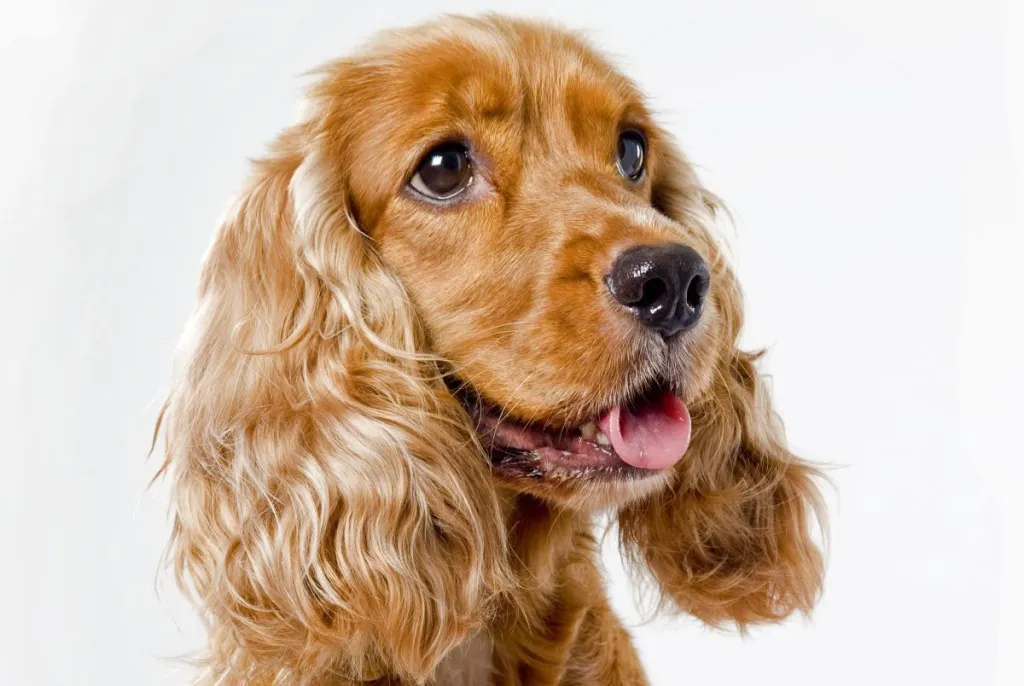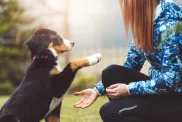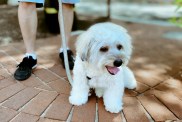Sometimes referred to as the American Cocker Spaniel, the Cocker Spaniel is a beloved and popular breed. Known for their sweet temperament and beautiful appearance, these dogs have medium-sized bodies covered in silky fur. Their large, expressive eyes exude intelligence and affection, while their long, feathered ears add to their charming appeal.
Active, affectionate, and energetic dogs, this breed is always eager to participate in family activities. They thrive on human companionship and are known for forming strong bonds with their owners. Whether it’s playing fetch or going for a long walk, they are always up for some fun.
One of their standout qualities is their keen sense of smell and exceptional hunting abilities. Although they are no longer primarily used for hunting, their instincts remain intact. They enjoy following scent trails during walks, making their outings an adventure for both dog and owner.
Socialization is crucial for this breed from an early age. They are generally friendly and affectionate towards people and other pets when well-socialized. Without proper exposure, they may develop shyness or fearfulness. Positive interactions and experiences with different environments, people, and animals are essential.
Quick Facts
- Origin: United States
- Purpose: Hunting
- Height: 14-15 inches (male), 13-14 inches (female)
- Weight: 25-30 pounds (male), 20-25 pounds (female)
- Lifespan: 12-15 years
- Temperament: Friendly, affectionate, playful, gentle
- Grooming needs: Moderate
- Exercise requirements: High
- Training: Relatively easy to train, but can be stubborn at times
- Health problems: Hip dysplasia, elbow dysplasia, eye problems
- Disney’s 1955 animated film “Lady and the Tramp” featured a beautiful, lively Cocker Spaniel named Lady.
- Cocker Spaniels have been beloved by a number of celebrities including Shirley Temple, Lauren Bacall, John F. Kennedy, Oscar de la Renta, Elton John, Lucille Ball, and Oprah Winfrey to name a few.
Although Cocker Spaniels share similarities with their English relatives, they do have some distinct differences. The American version is slightly smaller in size and has a head with a domed shape. Both breeds are known for their loving and affectionate nature, but the English Cocker Spaniel tends to have a higher prey drive and displays more energy compared to the American Cocker Spaniel.
Cocker Spaniel Pictures
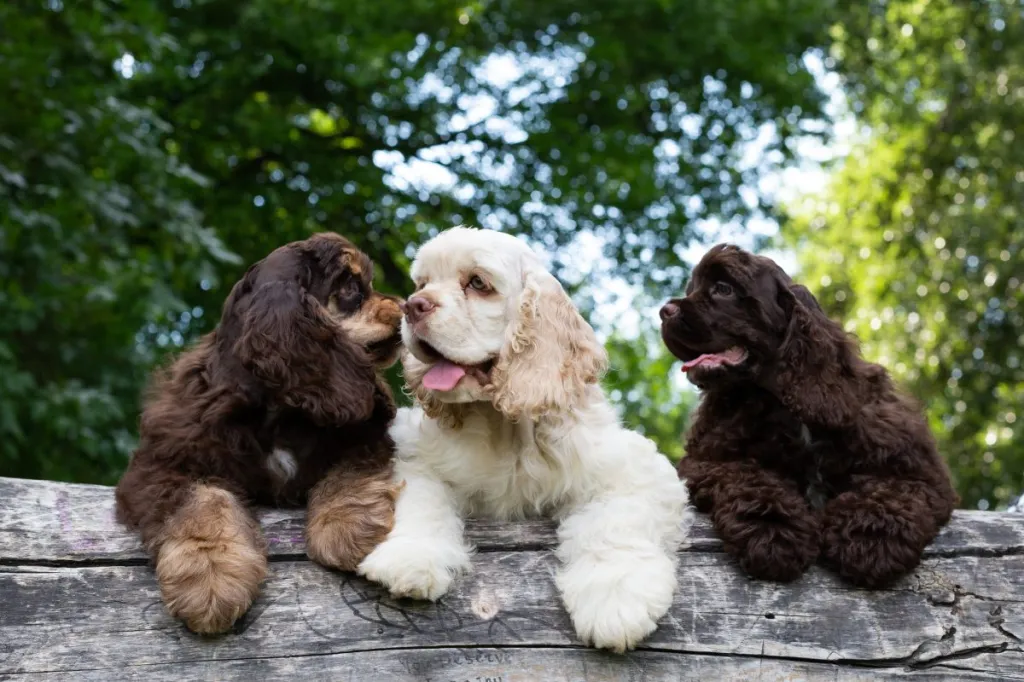
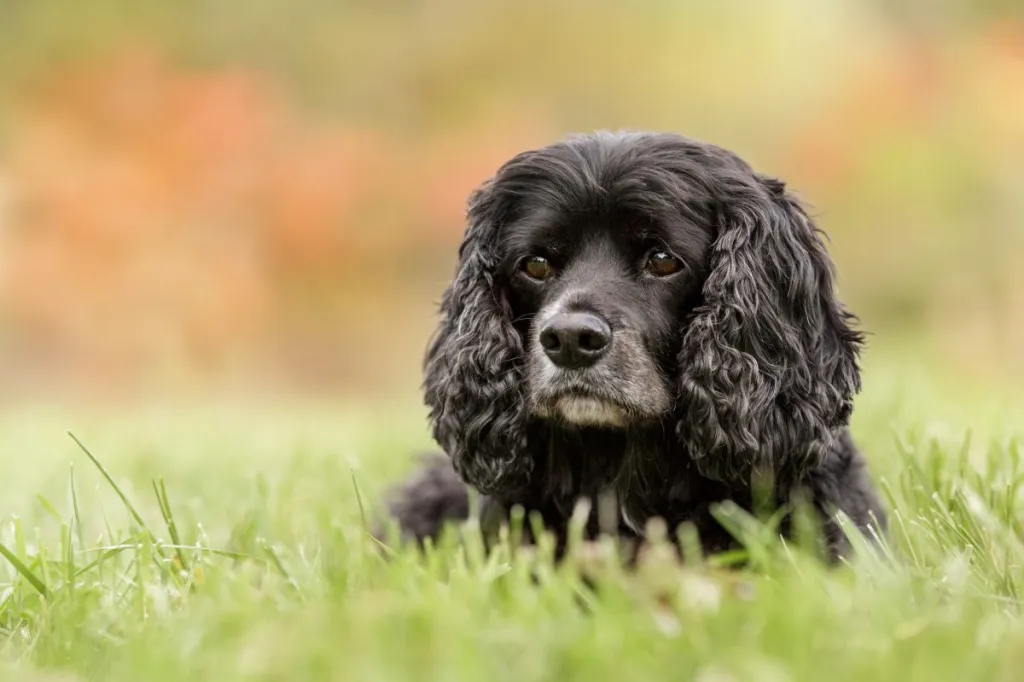
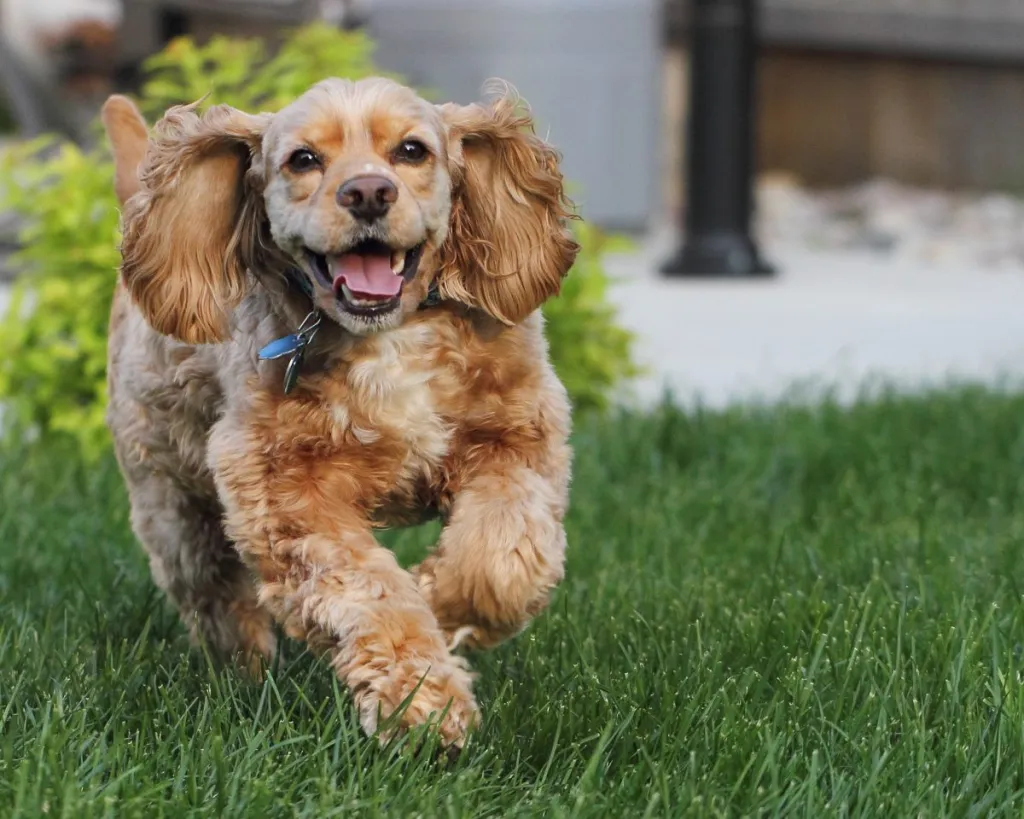
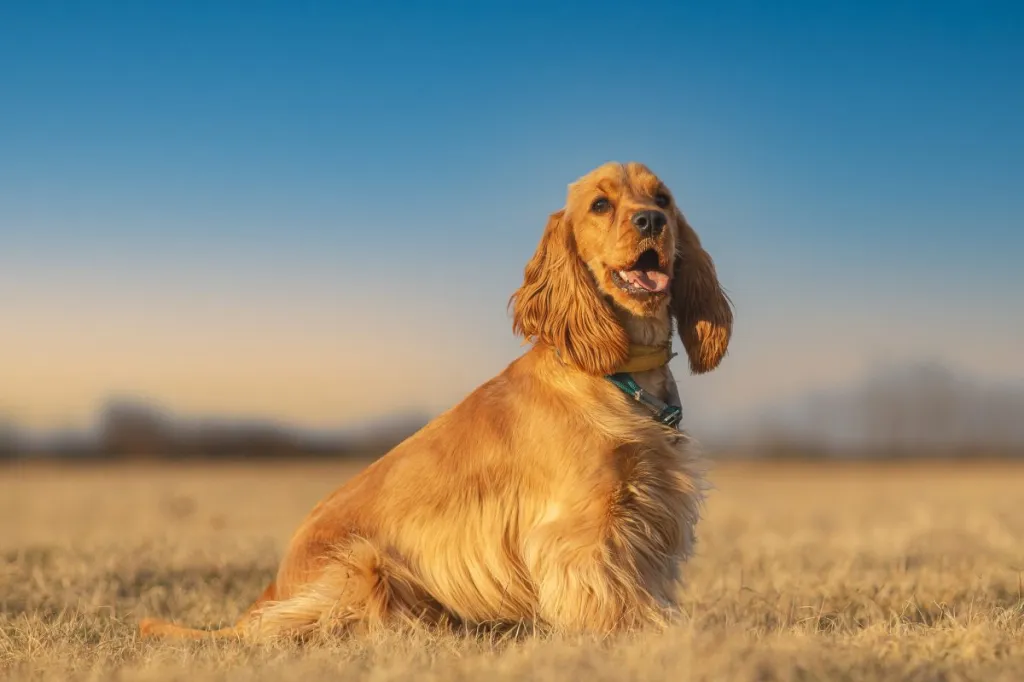
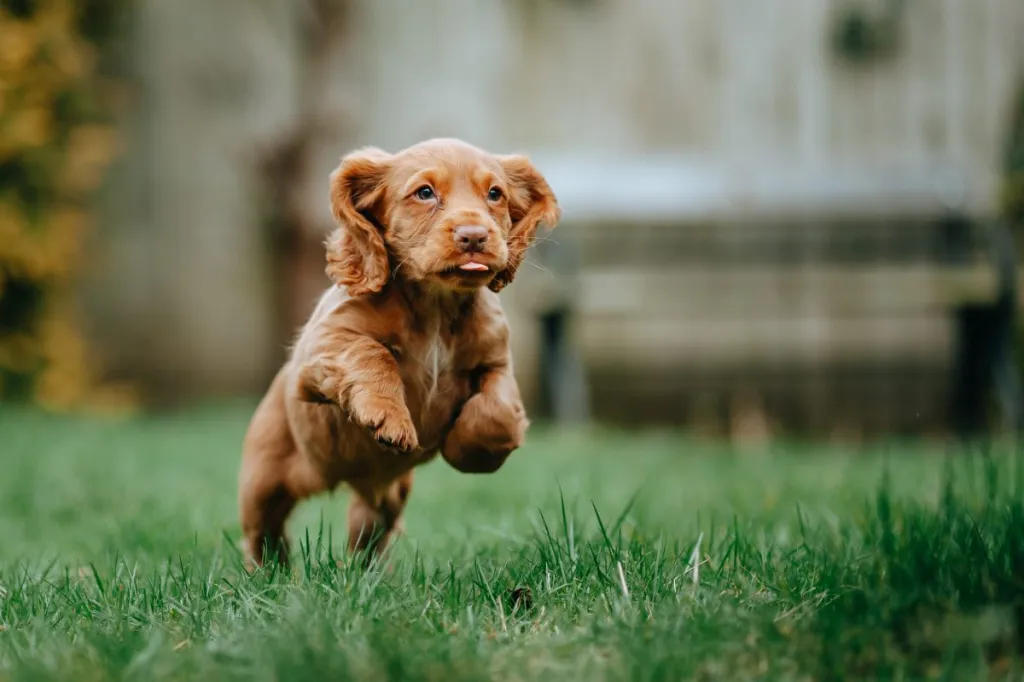
Adaptability
-
Adapts Well To Apartment Living
Looking for the best dog for your apartment? Contrary to popular belief, the suitability of dogs who adapt well to apartment living goes beyond its size. Apartment dwellers have a myriad of dog breeds to choose from as potential companions, with various factors to consider. Some large breeds can adapt well to apartment living and have lower activity levels. Others may require more space and possess higher energy levels. On the other hand, certain small dog breeds with abundant energy can still find contentment with indoor playtime or brisk walks.
However, when selecting a dog that adapts well apartments, it is essential to prioritize your neighbors. Opting for a pet that doesn’t excessively bark and behaves politely when encountering others in shared spaces like is crucial for maintaining a harmonious apartment environment.
In high-rise settings, it’s worth noting that numerous small dogs may exhibit a propensity for high energy and frequent barking. This makes them less suitable for apartment living. Therefore, desirable qualities in an apartment dog encompass being quiet, low-energy, and displaying polite behavior towards other residents.
Factors To Consider When Choosing A Dog For An Apartment
When considering dogs that adapt well to apartments, size alone should not be the sole determinant. Apartment dwellers have a wealth of dog breeds to choose from as potential furry companions. It’s important to remember that the size of your living space is just one factor to consider. While some larger breeds can adapt well to apartment living, with lower, others may require more space and have higher energy levels, making them less suitable for smaller apartments. Conversely, certain small dog breeds with higher energy levels can still thrive in apartments, finding contentment through indoor playtime or brisk walks. However, it is crucial to consider your neighbors’ comfort when selecting a dog. Opt for a pet that doesn’t bark excessively and behaves politely when interacting with others in shared spaces.
Therefore, it’s important to prioritize qualities such as being quiet, low-energy, calm indoors, and exhibiting good manners when living in close proximity to other residents. By considering these factors, you can find a dog that will adapt well to apartment living and create a harmonious living environment for everyone involved.
-
Good For Novice Owners
Some dogs are simply easier than others; they take to training better and are fairly easygoing. They’re also resilient enough to bounce back from your mistakes or inconsistencies.
Dogs who are highly sensitive, independent thinking, or assertive may be harder for a first-time dog parent to manage. You’ll get your best match if you take your dog-owning experience into account as you choose your new pooch.
If you’re new to dog parenting, take a look at 101 Dog Tricks and read up on how to train your dog!
-
Sensitivity Level
Some dogs will let a stern reprimand roll off their backs, while others take even a dirty look to heart. Low-sensitivity dogs, also called “easygoing,” “tolerant,” “resilient,” and even “thick-skinned,” can better handle a noisy, chaotic household, a louder or more assertive owner, and an inconsistent or variable routine. Do you have young kids, throw lots of dinner parties, play in a garage band, or lead a hectic life? Go with a low-sensitivity dog.
-
Tolerates Being Alone
Some breeds bond very closely with their family and are more prone to worry or even panic when left alone by their owner. An anxious dog can be very destructive–barking, whining, chewing, and otherwise causing mayhem. These breeds do best when a family member is home during the day or if you can take the dog to work.
-
Tolerates Cold Weather
Breeds with very short coats and little or no undercoat or body fat, such as Greyhounds, are vulnerable to the cold. Dogs with a low cold tolerance need to live inside in cool climates and should have a jacket or sweater for chilly walks. You can find a great jacket for your dog here!
-
Tolerates Hot Weather
Dogs with thick, double coats are more vulnerable to overheating. So are breeds with short noses, like Bulldogs or Pugs, since they can’t pant as well to cool themselves off. If you want a heat-sensitive breed, your dog will need to stay indoors with you on warm or humid days, and you’ll need to be extra cautious about exercising your dog in the heat.
All-around friendliness
-
Affectionate With Family
When it comes to unconditional love and unwavering loyalty, few animals can rival the affectionate nature of dogs. These remarkable creatures have earned their reputation as man’s best friend, and many breeds are particularly renowned for their love and devotion to their families. With their warm hearts and wagging tails, affectionate family dogs enrich the lives of their owners in countless ways.
One such breed known for its affectionate demeanor is the Golden Retriever. With their gentle temperament and friendly disposition, Golden Retrievers form deep bonds with their families. They eagerly participate in family activities, whether it’s a game of fetch in the yard or cuddling on the couch during a movie night. Their expressive eyes and ever-wagging tails are a testament to the joy they feel in the presence of their loved ones.
Another family-favorite breed is the Labrador Retriever. Renowned for their playful and patient nature, Labradors are excellent companions for children and adults alike. They readily engage in playtime with the kids, showcasing their boundless energy and enthusiasm. But when the day winds down, they seamlessly transition into loving and gentle cuddle buddies, comforting their family members with their warm presence.
Beyond specific breeds, mixed-breed dogs also have a special place in the hearts of families seeking affectionate companions. The shelter dogs, in particular, form deep connections with their adoptive families. They seem to understand the second chance they’ve been given and repay it with endless love and gratitude.
How To Know If A Dog Is Good With Families
The affectionate nature of family dogs extends beyond play and cuddles. Dogs have a remarkable ability to sense their owner’s emotions, offering comfort and support during difficult times. Whether it’s a wagging tail after a long day at work or a sympathetic nuzzle during moments of sadness, they prove time and again that they are attuned to their family’s needs.
It is important to note that not all dogs of the same breed will be equally affectionate. Some dogs may be more independent or aloof, while others may be more clingy or demanding of attention. The best way to find out how affectionate a dog is is to meet them in person and interact with them.
-
Kid-Friendly
Being gentle with children, sturdy enough to handle the heavy-handed pets and hugs they can dish out, and having a blasé attitude toward running, screaming children are all traits that make a kid-friendly dog. You may be surprised by who’s on that list: Fierce-looking Boxers are considered good with children, as are American Staffordshire Terriers (which are considered Pit Bulls). Small, delicate, and potentially snappy dogs such as Chihuahuas aren’t always so family-friendly.
**All dogs are individuals. Our ratings are generalizations, and they’re not a guarantee of how any breed or individual dog will behave. Dogs from any breed can be good with children based on their past experiences, training on how to get along with kids, and personality. No matter what the breed or breed type, all dogs have strong jaws, sharp pointy teeth, and may bite in stressful circumstances. Young children and dogs of any breed should always be supervised by an adult and never left alone together, period.
-
Dog Friendly
Friendliness toward dogs and friendliness toward humans are two completely different things. Some dogs may attack or try to dominate other dogs, even if they’re love-bugs with people; others would rather play than fight; and some will turn tail and run. Breed isn’t the only factor. Dogs who lived with their littermates and mother until at least six to eight weeks of age and who spent lots of time playing with other dogs during puppyhood, are more likely to have good canine social skills.
-
Friendly Toward Strangers
Stranger-friendly dogs will greet guests with wagging tails and nuzzles; others are shy, indifferent, or even aggressive. However, no matter what the breed, a dog who was socialized and exposed to lots of different types, ages, sizes, and shapes of people as a puppy will respond better to strangers as an adult. Remember that even friendly dogs should stay on a good, strong leash like this one in public!
Health And Grooming Needs
-
Amount Of Shedding
If you’re going to share your home with a dog, you’ll need to deal with some level of dog hair on your clothes and in your house. However, shedding does vary greatly among the breeds. Some dogs shed year-round, some “blow” seasonally, some do both, and some shed hardly at all. If you’re a neatnik, you’ll need to either pick a low-shedding breed or relax your standards. To help keep your home a little cleaner, you can find a great de-shedding tool here!
-
Drooling Potential
Drool-prone dogs may drape ropes of slobber on your arm and leave big, wet spots on your clothes when they come over to say hello. If you’ve got a laid-back attitude toward slobber, fine; but if you’re a neatnik, you may want to choose a dog who rates low in the drool department.
-
Easy To Groom
Some breeds are brush-and-go dogs; others require regular bathing, clipping, and other grooming just to stay clean and healthy. Consider whether you have the time and patience for a dog who needs a lot of grooming, or the money to pay someone else to do it.
-
General Health
Due to poor breeding practices, some breeds are prone to certain genetic health problems, such as hip dysplasia. This doesn’t mean that every dog of that breed will develop those diseases; it just means that they’re at an increased risk.
If you’re adopting a puppy, it’s a good idea to find out which genetic illnesses are common to the breed you’re interested in. You may also want to ask if your shelter or rescue has information about the physical health of your potential pup’s parents and other relatives.
-
Potential For Weight Gain
Some breeds have hearty appetites and tend to put on weight easily. As in humans, being overweight can cause health problems in dogs. If you pick a breed that’s prone to packing on pounds, you’ll need to limit treats, make sure they get enough exercise, and measure out their daily food servings into regular meals rather than leaving food out all the time.
Ask your vet about your dog’s diet and what they recommend for feeding your pooch to keep them at a healthy weight. Weight gain can lead to other health issues or worsen problems like arthritis.
-
Size
Get ready to meet the giants of the doggy world! Large dog breeds aren’t just big balls of fluff, they’re like loving, oversized teddy bears on a mission to steal your heart. Need some convincing? Let’s dive into the awesome benefits of owning one!
First things first, these pooches are a living security system! With their impressive size and thunderous barks, they’ll have any would-be intruder running for the hills. Talk about peace of mind! Plus, who needs an alarm when you’ve got a furry giant protecting your castle?
But that’s not all. Large dog breeds are all about loyalty and devotion. They’ll stick by your side through thick and thin, becoming your most dedicated bestie. Their love knows no bounds! When you have a giant fluffball showing you unconditional love, you’ll feel like the luckiest human on the planet.
Now, let’s talk about their talents. These big fellas are the ultimate working partners. With brains and brawn, they’re up for any challenge. From search and rescue missions to lending a helping paw to those in need, these dogs are superheroes in fur coats. They’ll make you proud every step of the way!
Don’t let their size fool you—these gentle giants have hearts as big as their paws. They’re incredible with kids and other pets, spreading their love like confetti. Their patience and kindness make them perfect family pets, ensuring harmony in your household.
Oh, and get ready to break a sweat! These dogs are fitness enthusiasts, and they’ll keep you on your toes. Daily walks, jogs, and play sessions will not only keep them happy and healthy but will also give you a reason to ditch the couch and join in on the fun. It’s a win-win situation!
So, if you’re ready for a dose of big love, go ahead and consider a large dog breed. They’re the best wing-dog you could ever ask for, ready to make your life a thousand times more exciting, loving, and downright awesome! Get ready for the big adventure of a lifetime!
Trainability
-
Easy To Train
Easy-to-train dogs are more adept at forming an association between a prompt (such as the word “sit”), an action (sitting), and a consequence (getting a treat) very quickly. Other dogs need more time, patience, and repetition during training.
Many breeds are intelligent but approach training with a “What’s in it for me?” attitude, in which case you’ll need to use rewards and games to teach them to want to comply with your requests.
Related:
10 Fun, Impressive Tricks You Can Teach Any Dog
-
Intelligence
Dogs who were bred for jobs that require decision making, intelligence, and concentration, such as herding livestock, need to exercise their brains, just as dogs who were bred to run all day need to exercise their bodies. If they don’t get the mental stimulation they need, they’ll make their own work–usually with projects you won’t like, such as digging and chewing. Obedience training and interactive dog toys are good ways to give a dog a brain workout, as are dog sports and careers, such as agility and search and rescue.
-
Potential For Mouthiness
Common in most breeds during puppyhood and in Retriever breeds at all ages, mouthiness means a tendency to nip, chew, and play-bite (a soft, fairly painless bite that doesn’t puncture the skin). Mouthy dogs are more likely to use their mouths to hold or “herd” their human family members, and they need training to learn that it’s fine to gnaw on chew toys, but not on people. Mouthy breeds tend to really enjoy a game of fetch, as well as a good chew on a toy that’s been stuffed with kibble and treats.
-
Prey Drive
Dogs with a high prey drive have an instinctive desire to stalk, capture, and prey upon potential food sources. Dogs who were bred to hunt, such as Terriers, have an inborn desire to chase — and sometimes kill — other animals. Anything whizzing by — such as cats, squirrels, and perhaps even cars — can trigger that instinct.
How to address a high prey drive
Off-leash adventures are too great a temptation for pups who will wander and hunt. Dogs who like to chase need to be leashed. And, even on a leash, you may experience your dog pulling on the leash to reach rodents or birds in their sight. Otherwise, these pups should be kept in a fenced area when outdoors. If your pup has a high prey drive, you’ll need a high, secure fence in your yard.
These breeds generally aren’t a good fit for homes with smaller pets that can look like prey, such as cats, hamsters, or small dogs. Breeds that were originally used for bird hunting, on the other hand, generally won’t chase, but you’ll probably have a hard time getting their attention when there are birds flying by.
Other behavioral concerns
Observing your dog’s prey drive, which is instinctual and biologically-rooted, is not the same as observing aggression. Much aggression is born of fear and anxiety, especially in the case of dog aggression toward humans.
The tendency to wander, even into oncoming traffic, can produce diasterious results for pups with predatory instincts. It can also lead to pups being bitten by snakes or attacked by other wild animals they may pursue while on the hunt.
-
Tendency To Bark Or Howl
Some breeds sound off more often than others. When choosing a breed, think about how often the dog vocalizes. Learn more about breeds with a tendency to bark or howl.
If you’re considering a hound, would you find their trademark howls musical or maddening? If you’re considering a watchdog, will a city full of suspicious “strangers” put your pup on permanent alert? Will the local wildlife literally drive your dog wild? Do you live in housing with noise restrictions? Do you have neighbors nearby? Then you may wish to choose a quieter dog.
-
Wanderlust Potential
Some breeds are more free-spirited than others. Nordic dogs such as Siberian Huskies were bred to range long distances, and given the chance, they’ll take off after anything that catches their interest. And many hounds simply must follow their noses–or that bunny that just ran across the path–even if it means leaving you behind.
Exercise needs
-
Energy Level
High-energy dogs are always ready and waiting for action. Originally bred to perform a canine job of some sort, such as retrieving game for hunters or herding livestock, they have the stamina to put in a full workday. They need a significant amount of exercise and mental stimulation, and they’re more likely to spend time jumping, playing, and investigating any new sights and smells.
Low-energy dogs are the canine equivalent of a couch potato, content to doze the day away. When picking a breed, consider your own activity level and lifestyle, and think about whether you’ll find a frisky, energetic dog invigorating or annoying.
-
Intensity
A vigorous dog may or may not have high energy, but everything they do, they do with vigor: they strain on the leash (until you train them not to), try to plow through obstacles, and even eats and drinks with great big gulps. These dynamos need lots of training to learn good manners, and may not be the best fit for a home with young kids or someone who’s elderly or frail. A low-vigor dog, on the other hand, has a more subdued approach to life.
-
Exercise Needs
Some breeds do fine with a slow evening stroll around the block. Others need daily, vigorous exercise, especially those that were originally bred for physically demanding jobs, like herding or hunting.
Without enough exercise, these breeds may put on weight and vent their pent-up energy in ways you don’t like, such as barking, chewing, and digging. Breeds that need a lot of exercise are good for outdoorsy, active people, or those interested in training their dog to compete in a high-energy dog sport, such as agility.
-
Potential For Playfulness
Some dogs are perpetual puppies — always begging for a game — while others are more serious and sedate. Although a playful pup sounds endearing, consider how many games of fetch or tag you want to play each day, and whether you have kids or other dogs who can stand in as playmates for the dog.
Cocker Spaniel Overview
The Cocker Spaniel holds a special place as the smallest member of the American Kennel Club Sporting Group and has captured the hearts of many pet owners across the United States. Remember the endearing female lead in Lady and the Tramp? It’s no wonder that the model of an affectionate and pampered pet was a Cocker Spaniel. Back in the late 1930s to the 1950s, the Cocker reigned as the top AKC-registered breed. While its popularity declined for about three decades, it experienced a resurgence in the mid-1980s, briefly reclaiming the number-one status until Labrador and Golden Retrievers took over in 1992. Presently, the Cocker remains among the top 15 registered breeds, and it’s not difficult to see why. A well-bred Cocker Spaniel is an absolute joy to have as a companion, boasting a merry and sound temperament.
With its flowing and handsome coat, the Cocker Spaniel is a loving and gentle breed that seeks nothing more than to make its family happy. Despite being part of the Sporting Group, it is smaller in size, weighing between 20 to 30 pounds, making it a perfect fit for apartment living or smaller homes. While primarily a devoted companion, the Cocker is versatile and can excel in conformation show rings, obedience and agility competitions, and field work. Moreover, it excels as a therapy dog, bringing comfort and joy to those in need.
Originally considered one with the English Cocker Spaniel, the breed was recognized as distinct by the American Kennel Club in 1946. The typical Cocker Spaniel is known for its gentle and trustworthy nature, making it an ideal family pet that gets along well with children, other animals, and the elderly.
However, its immense popularity has attracted some unscrupulous breeders who disregard temperament, health, and conformation in their breeding practices. As a result, some Cocker Spaniels suffer from serious health and temperament issues. If you are considering adding a Cocker Spaniel to your family, it is vital to be extremely cautious about where you purchase or adopt a puppy. Reputable breeders prioritize temperament and perform various health tests on their breeding dogs to ensure they don’t pass on genetic diseases. Always buy from reputable breeders and avoid backyard breeders, puppy mills, or pet stores. By choosing wisely, you can welcome a wonderful and cherished companion into your life.
Cocker Spaniel Highlights
Due to their widespread popularity, it becomes particularly crucial to research breeders diligently and find one committed to enhancing the Cocker Spaniel breed. These sensitive dogs can sometimes display nervousness, even if they come from a reputable breeder and have received proper socialization. It’s not uncommon for Cockers to exhibit submissive urination when excited, so be prepared for this behavior.
Cockers have a tendency to bark, so including a “Quiet” command in their training repertoire is essential. They are highly eager to please and enjoy being close to their families. However, being originally bred as hunting dogs, it shouldn’t surprise you if your Cocker chases birds or small animals during walks. Always keep them on a leash unless in a secure, fenced area.
The Cocker Spaniel possesses a gentle and “soft” personality, making harsh training methods counterproductive and likely to instill fear. Opt for gentle, consistent training to achieve the best results with these affectionate dogs.
While the long ears of the Cocker Spaniel contribute to their beauty, they can also pose potential health issues. Regularly checking their ears for infections is essential to keep them healthy and comfortable.
Maintaining the Cocker’s beautiful coat requires significant effort and expense. Expect to enlist the services of a professional groomer and dedicate time to daily brushing to keep their fur in top condition.
To ensure you have a healthy and happy pet, it is crucial to avoid purchasing puppies from backyard breeders, puppy mills, or pet stores. Instead, seek out reputable breeders who conduct genetic health tests on their breeding dogs and prioritize good temperaments. This careful approach will lead you to a wonderful and well-cared-for Cocker Spaniel.
Cocker Spaniel History
The modern Cocker Spaniel traces its roots back to the ancient Spaniel family, believed to have originated in Spain, hence the name “spaniel,” meaning “Spanish dog.” By the 1800s, Spaniels were classified into two groups: toys, serving primarily as companions, and large hunting dogs, further divided into land and water spaniels. The Cocker Spaniel earned its name due to its exceptional hunting abilities, particularly in pursuing woodcock.
In England, spaniels were considered a functional category rather than individual breeds for many centuries. It was only in 1892 that the Cocker Spaniel was officially recognized as a distinct breed in England, with the Obo Kennel of Mr. James Farrow being the first to gain recognition for these dogs.
In the late 1870s, American enthusiasts started importing English Cockers to the United States. The breed’s popularity grew rapidly, leading to the formation of the American Spaniel Club in 1881, initially including breeders of various Spaniel types. As differences among Spaniel breeds became more defined, separate organizations were formed.
Over time, some breeders favored a smaller type of Cocker Spaniel with slightly different conformation, particularly flashy in the show ring. In 1936, English Cocker breeders established the English Cocker Spaniel Club of America, gaining AKC recognition for the English type. They resolved not to breed English Cockers with American-type Cockers, further solidifying the distinction.
In 1939, CH My Own Brucie, a black Cocker Spaniel, achieved remarkable success at the prestigious Westminster Dog Show, captivating the American public with his charm. Brucie’s triumph contributed to the soaring popularity of Cocker Spaniels and shifted American breeders’ focus more towards breeding for the show ring than fieldwork.
The increasing divergence between American and English Cockers prompted the American Kennel Club to formally recognize them as two separate breeds in 1946, solidifying the distinct identities of the American Cocker Spaniel and the English Cocker Spaniel.
Cocker Spaniel Size
The American Cocker Spaniel is a charming breed, with males typically standing 15 inches tall at the shoulder, while females are slightly smaller at 14 inches tall. Both males and females have a weight range of 24 to 28 pounds, making them a compact and delightful companion for any family. Their endearing size and gentle nature add to their appeal, making them a beloved breed among pet owners.
Cocker Spaniel Personality
The well-bred Cocker Spaniel boasts a sweet temperament that wins hearts effortlessly. Affectionate and cuddly, this delightful dog thrives on being an active part of family activities. Playful, alert, and ever-active, the Cocker happily engages in various exercises, be it a brisk walk or the thrill of hunting in the field.
Given the Cocker’s sensitive nature, both mentally and physically, gentle and considerate handling is essential. Harsh treatment is best avoided, as it can lead to undesirable reactions such as growling or snapping when the dog is in pain or fearful. Early socialization and proper training are vital to instill appropriate canine manners and ensure a well-balanced and well-behaved companion.
To bring out the best in the Cocker’s personality, it is crucial to treat them with care and kindness, as their “soft” disposition requires understanding and patience. In return, they offer boundless love and loyalty, making them cherished members of any loving family.
Cocker Spaniel Health
Cocker Spaniels, like all dog breeds, can be generally healthy, but they are susceptible to certain conditions and diseases.
Eye problems are a concern for Cockers and can manifest in various ways, including progressive retinal atrophy, leading to blindness; cataracts, causing a cloudy film over the eye; glaucoma, which results from increased eye pressure; and other eye abnormalities. If you observe redness in your Cocker’s eyes or notice excessive face rubbing, a visit to the vet for a checkup is advisable.
Autoimmune hemolytic anemia (AIHA) is another condition that can affect Cockers, where the dog’s immune system attacks its own blood cells. Symptoms include pale gums, fatigue, jaundice, and an enlarged liver signaled by a swollen abdomen. Treatment can be effective, but affected Cockers should not be bred.
Hypothyroidism, a disorder of the thyroid gland, may lead to epilepsy, hair loss, obesity, lethargy, dark patches on the skin, and other skin conditions. This condition is managed through medication and diet.
Primary seborrhea is a skin issue caused by excessive production of skin cells and sebaceous (oil) cells. It results in greasy, scaly skin with a foul odor, requiring treatment with medication and medicated baths.
Allergies are common in dogs, and Cockers are particularly prone to them. Food allergies can be managed by eliminating specific foods from the dog’s diet, while contact allergies are caused by reactions to topical substances like bedding or dog shampoos. Inhalant allergies result from airborne allergens like pollen or dust. Treatment varies depending on the cause and may involve dietary changes, medications, or environmental adjustments.
Idiopathic epilepsy, which is often inherited, can cause mild to severe seizures. However, it’s essential to consider that seizures can have various causes, such as metabolic disorders or exposure to poisons. If your dog experiences seizures, prompt veterinary attention is crucial to determine the underlying cause.
Canine hip dysplasia is an abnormal hip socket formation that can cause pain and lameness. Affected dogs should not be bred. If you’re acquiring a puppy, ensure the breeder can provide proof of the parents’ hip dysplasia testing and health.
Patellar luxation involves the dislocation of the kneecap, leading to pain and possible lameness. This condition, often affecting the hind leg, can be debilitating and requires medical attention.
Cocker Spaniel Care
The Cocker Spaniel is well suited to living in an apartment or condo — though of course he loves to share a house and yard. Although he doesn’t need vast space to roam, he does need daily activity. A daily romp in the yard along with a brisk 30-minute walk can keep him happy and trim. Then bring him inside with you — the Cocker is not pleased to be left alone outdoors for the day, and he may respond by digging or barking to keep himself amused. He’s most content when he’s with his family, participating in the group’s activities. Despite his beautiful locks and cute, round eyes, the Cocker Spaniel is a hunter at heart. He is also a good candidate for many canine sports, especially agility and obedience competitions, hunt tests, flyball, or tracking. Like most dogs, the Cocker is better behaved when active than when he’s allowed to get bored, which can lead to such behavior problems as barking, digging, and chewing.
Cocker Spaniel Feeding
The recommended daily amount of high-quality dry food for a Cocker Spaniel ranges from 1.5 to 2.5 cups. However, it’s important to be cautious, as Cockers have a hearty appetite and may overeat if given the opportunity. Their skillful use of big, brown eyes in begging for tidbits can melt anyone’s resolve, but it’s crucial not to give in, as an overweight Cocker can lead to health issues. To ensure you’re feeding your Cocker Spaniel appropriately, refer to our guidelines for selecting the right food, feeding a puppy, and feeding an adult dog.
Keep in mind that the exact amount your adult Cocker consumes depends on factors like size, age, build, metabolism, and activity level. Just like people, dogs are individuals, and their food requirements differ. Active dogs will need more food than couch potatoes. Moreover, the quality of the dog food you choose also plays a significant role. High-quality dog food provides better nourishment, meaning you’ll need to serve less of it in your dog’s bowl. Remember to focus on providing the best nutrition for your furry companion to ensure their overall health and well-being.
Cocker Spaniel Coat Color And Grooming
Few breeds can match the elegant appearance of a well-groomed Cocker Spaniel. Their thick, sometimes wavy coat adds to their charm, with shorter fur on the head and back, and longer tufts on the ears, chest, belly, and legs. The coat comes in solid colors such as black, light cream, red, or brown, as well as parti-colors with white combined with two or more colors. However, grooming a Cocker Spaniel can be an intensive and potentially expensive undertaking. Many owners choose to have professional groomers bathe, brush, and trim their dogs’ coats every six to eight weeks, given the time and effort required for this breed. Daily brushing at home is also essential to prevent tangles and mats.
If you are not prepared for the substantial grooming commitment, the Cocker Spaniel may not be the right choice for you. Some owners opt for shorter coat styles to make maintenance easier, but regular trimming and bathing every six to eight weeks remain necessary to keep the Cocker looking neat.
Proper introduction to grooming at an early age is crucial for the Cocker Spaniel. Their sensitive nature makes it essential to familiarize them with handling, brushing, the sound of clippers, scissoring, and other grooming tasks from a young age. Positive and kind lessons will help them become more cooperative during grooming sessions and vet visits.
Regular care should also include monthly nail trimming and weekly ear checks for dirt, redness, or odors that may indicate an infection. Cocker Spaniels are prone to ear infections, so attentive monitoring is vital. Wiping the ears with a cotton ball dampened with a gentle, pH-balanced ear cleaner can prevent problems. Using deep, narrow bowls for food and water can keep the ears dry and free from food particles, and some owners even use a snood to protect the ears while the Cocker eats. With proper grooming and care, the Cocker Spaniel will continue to exude its handsome and captivating appeal.
Cocker Spaniel Children And Other Pets
The popularity of the Cocker Spaniel as a family dog is well-deserved due to their excellent compatibility with children. When raised together and treated kindly and respectfully, the Cocker gets along famously with kids. However, because of their sensitive nature, it’s crucial that all interactions between the Cocker and children are closely supervised by a responsible adult. This ensures that both the dog and the children have a safe and enjoyable experience together.
Moreover, the Cocker Spaniel is known for its ability to get along with other family pets when introduced properly and with proper training. Whether it’s with dogs, cats, or small animals, the Cocker’s friendly disposition allows them to form positive relationships with their furry companions, making them a harmonious addition to multi-pet households.
Cocker Spaniel Rescue Groups
Cocker Spaniels are often bought without any clear understanding of what goes into owning one. There are many Cocker Spaniels in need of adoption and or fostering. There are a number of rescues that we have not listed and many can be found with a quick internet search.
Cocker Spaniel Breed Organizations
Finding a reputable dog breeder is one of the most important decisions you will make when bringing a new dog into your life. Reputable breeders are committed to breeding healthy, well-socialized puppies that will make great companions. They will screen their breeding stock for health problems, socialize their puppies from a young age, and provide you with lifetime support.
On the other hand, backyard breeders are more interested in making a profit than in producing healthy, well-adjusted dogs. They may not screen their breeding stock for health problems, and they may not socialize their puppies properly. As a result, puppies from backyard breeders are more likely to have health problems and behavioral issues.
